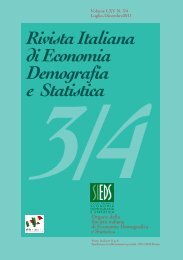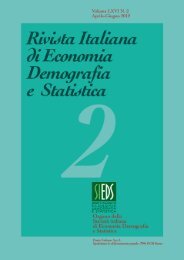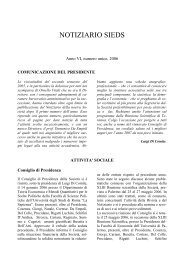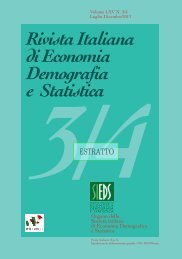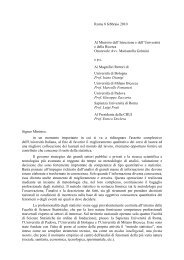rivista italiana di economia demografia e statistica - Sieds
rivista italiana di economia demografia e statistica - Sieds
rivista italiana di economia demografia e statistica - Sieds
Create successful ePaper yourself
Turn your PDF publications into a flip-book with our unique Google optimized e-Paper software.
Rivista Italiana <strong>di</strong> Economia Demografia e Statistica 213<br />
Greece. Women are particularly <strong>di</strong>sadvantaged in Denmark, France, Sweden and<br />
Germany (gender <strong>di</strong>fferences of more than 10 percentage points).<br />
As already stated above, in this work we want to shed light on the connection<br />
between home tenure and poverty status among older Europeans. With this purpose<br />
we will stick to the narrower notion of relative monetary poverty (lack of<br />
<strong>di</strong>sposable income), for reasons of simplicity. However, relative monetary poverty<br />
is strictly correlated with other spheres of deprivation. In SHARE only gross<br />
income (expressed in Euros) is collected. We converted gross into net income (see<br />
Vignoli, De Santis, 2009, for details on the procedure). We then obtained the net<br />
equivalent income by applying a standard equivalence scale: the square root of the<br />
number of household members. In particular we consider poor those in<strong>di</strong>viduals<br />
whose net equivalent income lies below the poverty threshold, 60% of the<br />
equivalent me<strong>di</strong>an net income for each country as calculated from SHARE.<br />
In Figure 1, we compare the prevalence of home ownership among all older<br />
households and, first, among all poor older household and second among a<br />
particularly vulnerable group: poor older women living alone. It is evident that<br />
poor households have a lower access to property anywhere, but <strong>di</strong>fferences are<br />
small where home ownership is widespread, larger elsewhere. In any country<br />
households composed by poor old women living alone have lower ownership rates<br />
than the poor households altogether. Surprisingly poor women living alone in<br />
Denmark, Sweden and the Netherlands are in a more severe con<strong>di</strong>tion with respect<br />
to the average of the older poor households.<br />
3. Do the poor have less access to home ownership?<br />
Table 1 presents the parameter of a logistic regression pre<strong>di</strong>cting the exclusion<br />
from home ownership, accor<strong>di</strong>ng to a set of demographic and socio-economic<br />
covariates (eventually survived as significant in a stepwise estimation procedure).<br />
The country-specific <strong>di</strong>fferences observed in our descriptive Figure 1 are here<br />
confirmed, also once we control for structural characteristics of the sample. Other<br />
things being equal, the exclusion from property is much more common in Austria,<br />
Sweden and Germany than in the Me<strong>di</strong>terranean cluster.<br />
If we do not find a clear trend by age, not surprisingly the less educated are<br />
more likely to be excluded by home ownership. Unemployed people, as well as<br />
those permanently sick and <strong>di</strong>sabled, seem more likely to be excluded from home<br />
ownership, suggesting that some of the most <strong>di</strong>sadvantaged segments of the<br />
population have also lower access to property. Conversely, and expectedly, being<br />
childless increases the odd ratio of owning the home where one live. This is<br />
possibly due to the fact that during the life-course old people might have left the<br />
property to their descendants (inter vivos transfers) or also that parents have less



